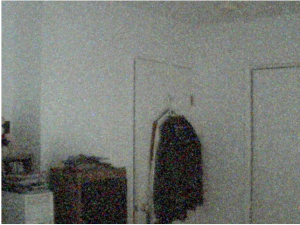As part of our home security system, I recently added a Hawking Tech HNC300 network camera. This camera, that costs about $100, has its own web server built in. This allows you, with the correct setup, to access your camera from anywhere on the Internet.
I'll talk a little about the camera itself then briefly describe what you need to do to setup viewing the camera outside of your home network.
The HNC300 is a 640 X 480 CMOS color video camera with its own built in CPU and web server. All you need to do to get an image out of it is to connect its Ethernet port to a network, plug in the power, and view the output via any Java/ActiveX enabled web browser on the network.
Unfortunately, the focal length of the camera (listed as 6 mm) is such that it has a very narrow field of view. This means that in a small room you won't be able to see much other than a very small portion of the wall opposite the camera. Since this is intended for indoor security surveillance, one has to wonder how big a house/office this camera is intended for. All I can say is it's almost useless in the small hovel known as the SetoShack(tm).
In addition, the image the camera transmit is not very good (click on the sample below to see the full, unretouched, 640 X 480 version). Notice how the image is full of digital noise, washed out, lacking in highlight and low light detail, and sharpness. I'm not entirely sure it is good enough for even its intended purpose of catching a burglar. I mean, if you did a video capture of the image and tried to use it to identify someone in a court of law the defense lawyer would have a field day.
If that wasn't bad enough, even though the camera specs says it can do 30fps, all I've ever gotten is, at the most, 1.5fps (within the home network). In fact, a typical frame rate for me, over the Internet, is less than one frame per second.
As to getting the image onto the Internet, you need to do two or three things. First, you need to assign a static address to the camera. If you are lucky enough to have a bunch of Class C addresses at your disposal your work is done. If you are like most people, you don't have any static addresses and you will be using something in the internal, non-routable IP address range of 192.168.0.XX.
For my network, where I use a Netgear FR318 8-port VPN router (similar to the newer FR328 here) using DHCP to assign IP addresses, I have to reserve an address and link it the MAC address of the camera. How you setup a static IP address on your network may be different but the process should be similar.
Also, I have to open a port in my firewall and forward it to the camera. The Netgear router has several ports pre-configured, including port 80 which is typically used for webservers, so all I had to do was enable the port and I was done on the internal network side.
Now comes the tedious part. Unless you have a static IP address, your Internet address is dynamically assigned and therefore, periodically changes. Hence, if you want reliable access from outside your home network to a particular resource, such as your web camera, without checking what your IP addrss happens to be at the moment, you have to use a service like DynDNS that creates a pseudo static address for you. There are other free services out there but this seems to be the most supported by consumer grade routers. Just sign up (follow the link to the Dynamic DNS(sm)) and choose a free domain, configure your router to use it, and every time you use your browser from outside your home to access the domain, DynDNS will point to your modem/router (and thence to your camera).
Most tech savvy people should be able to accomplish the above without too much trouble. For others, using the Hawking Tech camera, the Appendix of the CD-ROM based PDF manual tells you how to do most of the setup and the manual to your router hopefully tells you how to open the port and forward it to a specific resource. That said, this is not something for your Aunt Millie to be doing.
A note about security. I have no idea what operating system nor web server application the camera uses. Hence, I can't make any statements about how secure this setup is. By opening a port in your firewall you are not only making your presence known to the world (i.e, you are no longer "stealthed"), but you are inviting all of them in. This may not be a GoodThing. If you choose to follow what I did, you do so at your own risk. Don't come crying to me if some l33t hax0r 0wnzs your b0x. You have been warned.
While the Hawking Tech camera may not be the best, I don't know of too many other cams in the $100 range that have a server and CPU built in. If you know of any that are better, let me know.
Aloha!


Comments (1)
If you have a computer permanently running and connected -probably already serving things as the DynDNS people indicate- you might be better of just connecting a good quality webcam.
Posted by sjon | April 28, 2005 8:54 PM
Posted on April 28, 2005 20:54